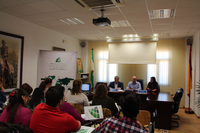The Fashion Workshop Seminar of Historical Reenactment dedicated to women clothing in the 18th Century finishes its first session
 1
/
1
1
/
1

The Workshop is organized by both the María Zambrano Center of Transatlantic Studies UMA-ATECH and the Macharaviaya Council
Categoría: Historia
The Fashion Workshop Seminar of Historical Reenactment, organized by both the María Zambrano Center of Transatlantic Studies UMA - ATECH and the Macharaviaya Council, closed last Saturday its first session making an overview of the women clothing at Bernardo de Gálvez time. The Workshop will continue next Saturday, 23rd April.
The Seminar opening was hosted by Antonio Campos Garín, Macharaviaya mayor, Juan Antonio García Galindo, María Zambrano Center director, and Mónica López Soler, workshop teacher and historian specialized in clothing and fashion design. The mayor of the municipality explained the international nature that Macharaviaya town shows, together with Pensacola city (Florida, EEUU), for being Bernardo de Gálvez birthplace, recently declared American honorary citizen. The Workshop, whose aim is the training for the vintage clothing production, is placed in Macharaviaya for the celebration of the American national festivity of the 4th July that the inhabitants celebrate every year wearing according the 70’s of the 18th century. At the same time, the Center director highlighted the pioneering aspect of managing an academic activity with the aim of helping the locality to improve, without forgetting the interest that the Workshop represents for the university community, as it offers a different attraction.
In this first session of the Workshop, the historian López Soler highlighted the importance of distinguishing between making a costume and building a character in the reenactment area. This way, she showed the participants the main points of the end of the 18th century clothing, emphasizing the silhouette and the costume volumes as keys for recognizing to which period the clothing belongs. To that end, she overviewed the most iconic dresses, like the Polish dress, the French coat or the rolled up dress, among others. Thus, he teacher provided a wide and visual bibliography for further consultations.
Likewise, she analyzed examples of historical reenactment clothing, made in the same town of Macharaviaya, making a practical exercise to the assistants of “costume readjustment”, where they marked, on dresses already made, both the anachronisms and the way of solving them. In the next session, the teacher will explain in detail the representative patterns and embroideries of the studies period, and will focus on the patterns of the most classic dresses.






